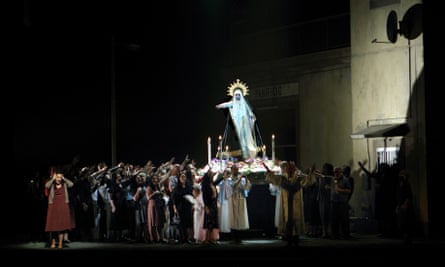It’s hard to believe that Damiano Michieletto’s production of opera’s best-known double bill got booed here two years ago. No doubt those few noisy people were still smarting from his controversial Guillaume Tell a few months earlier. Nobody’s taking aim at him this time, nor should they. Generally, Michieletto’s treatment of Mascagni’s and Leoncavallo’s one-acters is solid and almost cinematic in its detail. As revived by director Rodula Gaitanou, its temperature fluctuates according to who is on stage, though that may be Mascagni’s fault as much as anyone’s.
Michieletto is not the first director to dream up an intertwining of these two slabs of operatic misery, but he makes a notable success of it. With Paolo Fantin’s chunky revolving set representing the bakery and the community hall, both operas are set in a poor Italian village which attracts tragedy as swiftly and often as Ambridge or Albert Square. In Cavalleria’s intermezzo we see Pagliacci’s Nedda and Silvio, and what leads up to their first kiss; in Pagliacci’s orchestral interlude we see Cavalleria’s Santuzza being reconciled with Mamma Lucia – which is the more welcome for being a rare moment of light and hope in a dark evening.
Indeed, it’s Elena Zilio, returning as Mamma Lucia, who in many ways makes the biggest dramatic impression, her role bumped up hugely so that she is on stage for much of Cavalleria. She’s a more interesting character here than Elīna Garanča’s Santuzza, whose silvery, powerful singing – this is a distinctive and exciting voice – is an odd fit with her one-dimensional characterisation as a dowdy doormat, cringing away from an accusing statue of the Virgin that comes to nightmarish life.

Anna Pirozzi’s vampish Lola and Mark S Doss’s wide-boy Alfio offer sturdy support, but Daniel Oren’s energetic conducting doesn’t draw much nuance out of the orchestra; the introduction to the Intermezzo is promising, but then the Big Tune comes in with a massive thump.
It might be a blow to realism that Bryan Hymel, whose Turiddu was bleeding to death at the end of Cavalleria, clearly returns as Canio in Pagliacci – he’s standing in for Fabio Sartori for the first three performances of the run – but in other respects it’s a bonus; his focused, bullseye-hitting tenor sounds gripping in Vesti la giubba. Carmen Giannattasio is a fresh-sounding Nedda, Luis Gomes makes a lovely job of Beppe’s aria and, best of all, there’s a welcome return for Simon Keenlyside as a scheming Tonio who demands every bit of our attention.

Comments (…)
Sign in or create your Guardian account to join the discussion